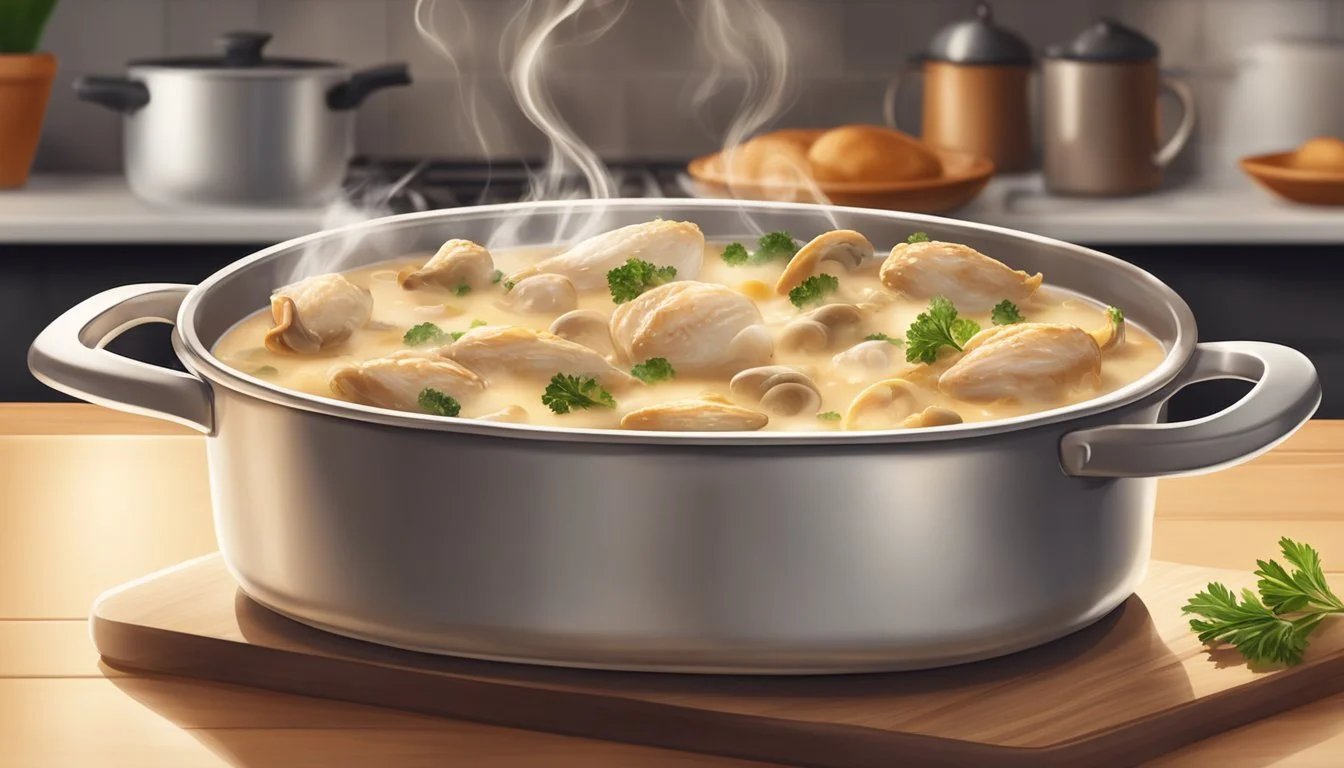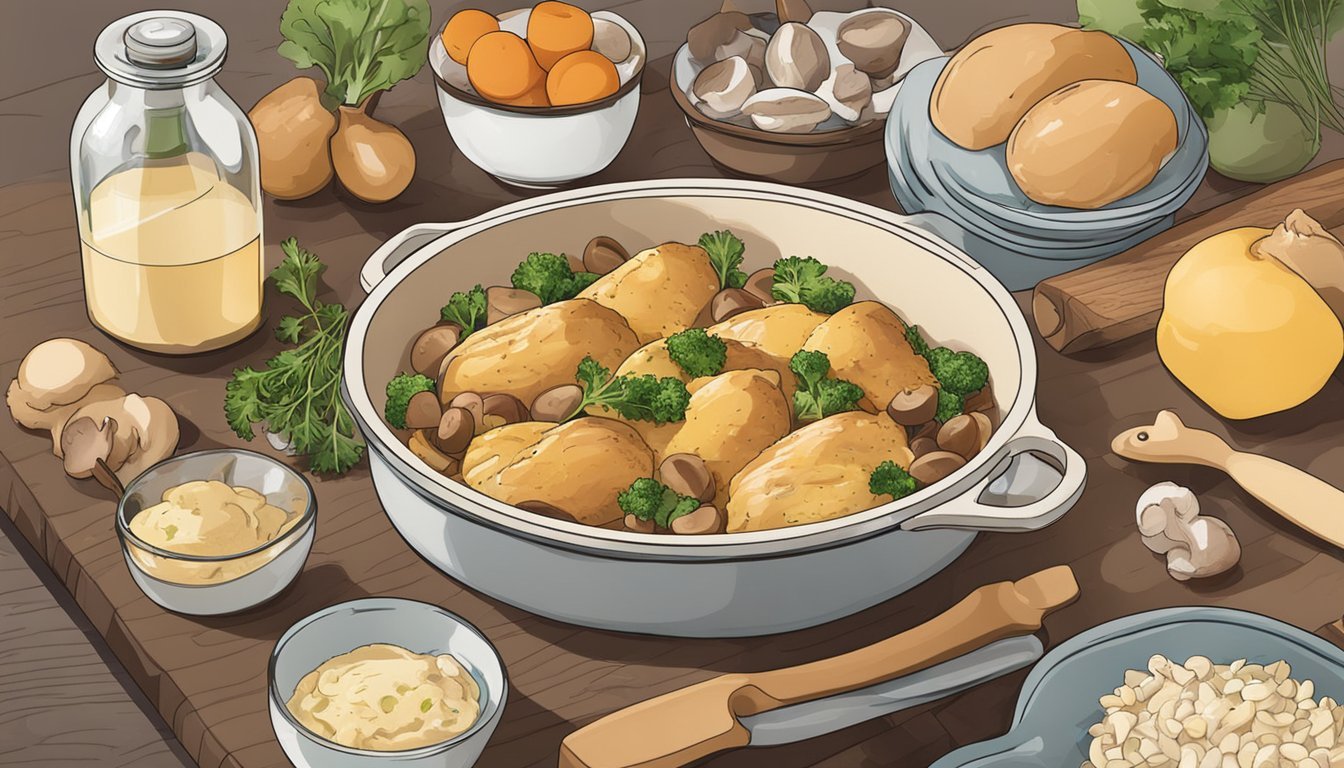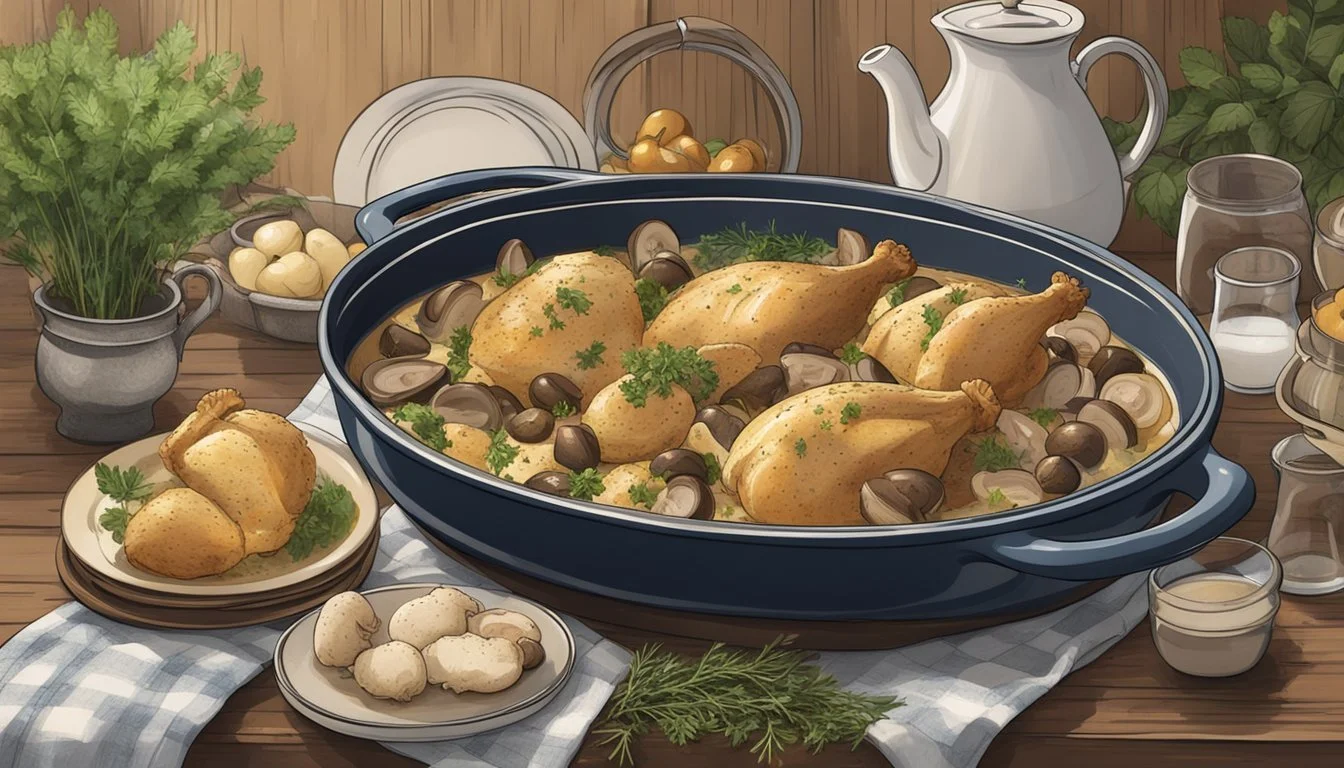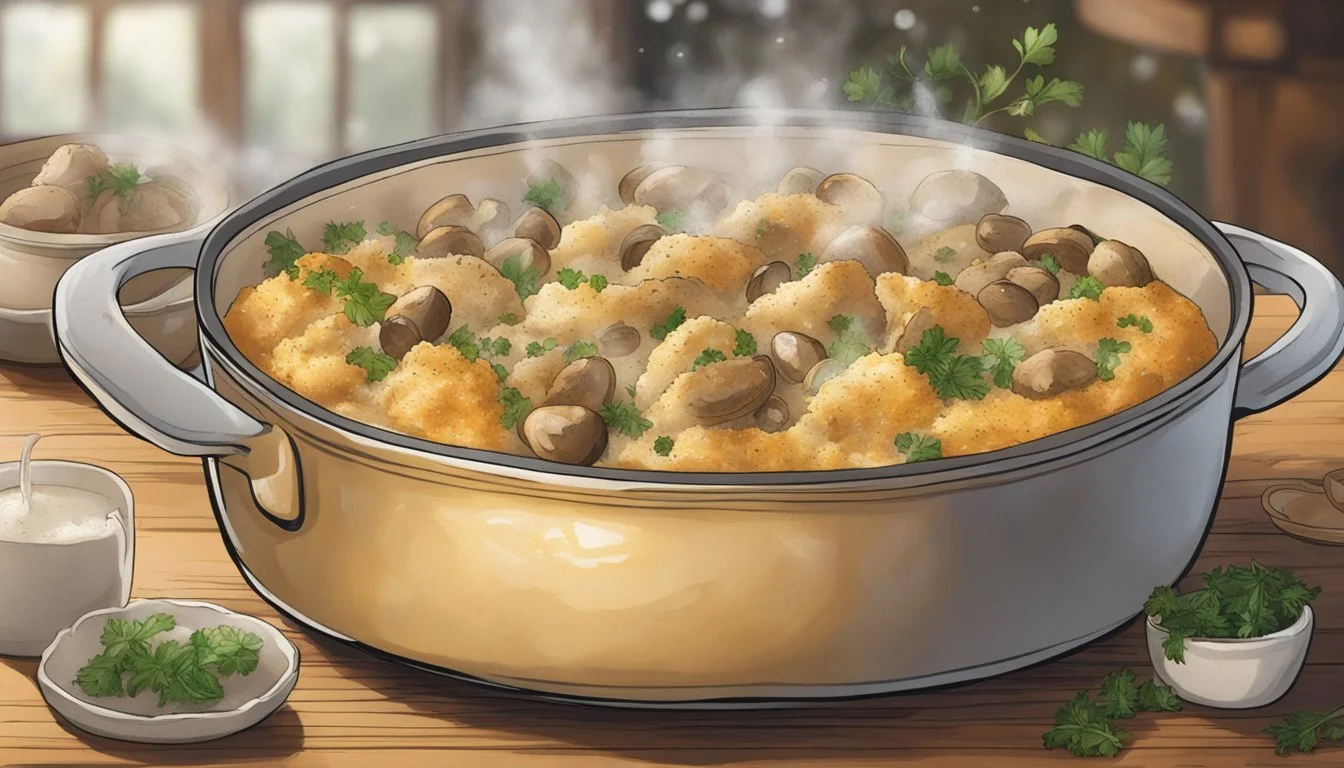How Long Does Chicken and Mushroom Casserole Last?
Shelf Life and Storage Tips
Chicken and mushroom casserole is a comforting dish that many enjoy, but knowing its shelf life is crucial for safety and quality. Typically, a homemade chicken and mushroom casserole can last in the refrigerator for up to 3-4 days when stored in an airtight container. This timeframe ensures that the flavors remain intact, and harmful bacteria have minimal chances to grow.
Understanding how long your casserole stays fresh helps avoid wasted food and ensures that each meal is enjoyed at its best. It's important to note that freezing the casserole can extend its shelf life, allowing you to keep it for up to 2-3 months without compromising on taste. Just remember to cool it completely before freezing to maintain the best texture and quality.
Following these storage guidelines not only preserves the dish but also keeps your family safe. Proper storage methods and a keen eye on shelf life can make a world of difference in your kitchen routine.
Understanding Chicken and Mushroom Casserole
Chicken and mushroom casserole combines tender chicken with hearty mushrooms in a savory sauce. It is a versatile dish that can be customized with a variety of ingredients and preparation methods.
Key Ingredients
Chicken: Usually, chicken breasts are used, but chicken thighs can offer a richer flavor. The chicken should be cut into bite-sized pieces for even cooking.
Mushrooms: Common choices include button mushrooms or cremini mushrooms. These add an earthy flavor and pair well with chicken.
Onion and Garlic: These aromatics are sautéed in butter or olive oil to form a flavorful base. They enhance the dish’s overall taste.
Broth and Dairy: Chicken broth mixed with ingredients like milk, half & half, or cream creates a smooth sauce. This mixture ensures the casserole is creamy and rich.
Cheese: Often added for an extra layer of flavor. Parmesan or mozzarella are popular choices.
Herbs and Spices: Parsley, thyme, and pepper are often used. These herbs add depth and aroma to the casserole.
Variations of the Casserole
Pasta: Some recipes include uncooked pasta, which cooks in the oven, absorbing the flavors of the sauce. This makes for a heartier dish.
Rice: Instant rice or pre-cooked rice can be mixed in for a different texture. The rice soaks up the mushroom sauce, making it deliciously moist.
Potatoes: Thinly sliced potatoes can replace pasta or rice for a starchy component. They offer a different texture and hearty bite.
Cheese Variations: Different types of cheese, such as Gruyère or cheddar, can alter the flavor profile significantly.
Additional Vegetables: Adding vegetables like celery, carrots, or bell peppers can enhance the nutritional value and complexity of the casserole.
Each variation allows for personalization according to taste and dietary needs, making chicken and mushroom casserole a beloved and adaptable dish.
Safe Storage Practices
Proper storage methods for chicken and mushroom casserole help prevent foodborne illnesses and ensure the casserole's freshness. The guidelines for refrigerating and freezing leftovers are essential for maintaining quality and safety.
Refrigeration Guidelines
Chicken and mushroom casserole should be stored in an airtight container and refrigerated immediately after cooling to 40°F (4°C) or below. According to food safety recommendations, the casserole can be kept in the fridge for 3 to 4 days.
To reheat, use a stove, oven, or microwave, ensuring the internal temperature reaches 165°F (74°C). Avoid multiple reheating cycles as this can impact both the quality and safety of the dish.
Freezing and Thawing
For longer storage, freezing is the best option. Portioning the casserole into individual servings before freezing can make future meal preparation easier. Ensure it is packed in freezer-safe containers or heavy-duty freezer bags to prevent freezer burn.
Label the containers with the freezing date and preferably consume within three to six months for optimal flavor. Thaw frozen casserole in the refrigerator overnight, never at room temperature. Reheat using a microwave, oven, or stove, ensuring it reaches an internal temperature of 165°F (74°C) before consuming.
Nutrition Profile
Chicken and mushroom casserole offers a balanced mix of macronutrients and an array of essential vitamins and minerals, making it a nutritious option for many.
Macronutrients and Calories
A typical serving of chicken and mushroom casserole contains protein, carbohydrates, and fat. The protein comes primarily from the chicken, which helps in muscle repair and growth.
Calories: Approximately 300-400 per serving
Protein: Around 25-30 grams
Carbohydrates: Around 20-25 grams, mostly from added pasta or rice
Fat: Roughly 10-15 grams, with a portion coming from saturated fat in the cheese or cream
Fiber content is usually low, about 2-3 grams, depending on the ingredients. It's also important to check sodium levels, which can be high due to broth and seasoned ingredients.
Vitamins and Minerals
Chicken and mushroom casserole provides several essential vitamins and minerals. Vitamin A and Vitamin C are generally low unless vegetables like carrots or peppers are included.
Iron: About 2-3 milligrams per serving, mainly from chicken and mushrooms
Potassium: Approximately 300-400 milligrams, helping in maintaining fluid balance
Calcium: Roughly 100 milligrams, particularly if cheese is used
Vitamin D: Present in mushrooms and enhanced dairy, contributing to bone health
Cholesterol in the dish can reach 80-100 milligrams, depending on meat and dairy quantities. For those watching cholesterol intake, opting for lean chicken and low-fat dairy can reduce these numbers effectively.
Casserole Preparation Tips
Proper preparation of chicken and mushroom casserole enhances both the taste and texture of the dish. Key steps include meticulous cooking techniques and thoughtful seasoning to bring out the best flavors.
Cooking Techniques
To ensure the casserole is cooked to perfection, preheat the oven to the recommended temperature, typically around 350°F to 425°F. Incorporate both raw chicken and mushrooms to achieve a rich and layered taste.
Using a meat thermometer, verify that the internal temperature of the chicken reaches 165°F (74°C). This ensures the chicken is fully cooked and safe to eat. Greasing the baking dish with oil or using nonstick cooking spray prevents sticking and makes for easy cleanup.
For the best results, cover the casserole with foil during baking to retain moisture. Removing the foil towards the end can help achieve a browned, crispy topping.
Seasoning and Flavor Enhancements
Seasoning plays a critical role in creating a flavorful casserole. Start with salt, pepper, and garlic powder to build a solid base. Adding chopped fresh parsley and thyme enhances the herbal notes of the dish.
Incorporating a mixture of chicken broth, milk, and lemon juice brings a subtle tanginess and creaminess that complements the earthiness of chestnut mushrooms. Adjust the salt and pepper to taste, ensuring a balanced flavor profile.
Consider garnishing with extra ground black pepper or fresh herbs before serving for added aroma and visual appeal.
Serving Suggestions
Chicken and mushroom casserole is a versatile dish that pairs well with a variety of sides and garnishes. By choosing the right accompaniments and presentation, you can elevate the dining experience for your guests.
Complementary Side Dishes
Serve chicken and mushroom casserole with creamy mashed potatoes or egg noodles to enhance its comforting nature. Garlic bread is also a popular choice, providing a crunchy contrast to the smooth texture of the casserole.
A green salad with fresh veggies like celery and beans offers a refreshing side that balances the richness of the dish. Caesar salad is another great option, combining the flavors of parmesan cheese and crisp lettuce.
Steamed or roasted asparagus is a delightful vegetable pairing. Its slightly bitter taste offsets the creamy elements. You might also try serving it with a medley of sautéed baby bella mushrooms and white mushrooms for added depth.
Presentation and Garnishing
When serving chicken and mushroom casserole, presentation can make a notable difference. Using a sprinkle of fresh parsley provides a pop of color and fresh aroma.
A light dusting of parmesan cheese or mozzarella cheese on top just before serving adds an extra layer of flavor. Cheddar can also be used for a sharper taste.
Serve individual portions in rustic bowls or on plated dishes for a homely feel. Adding a dollop of sour cream on top can introduce a tangy element that complements the savory casserole.
For an elegant touch, garnish with thinly sliced garlic cloves sautéed until golden. This not only adds visual appeal but also an additional layer of flavor.
Longevity and Quality Maintenance
Chicken and mushroom casserole can be enjoyed for several days if stored and reheated correctly. Proper assessment and correct storage methods are key in ensuring the dish retains its quality.
Assessing Casserole Condition
The condition of a chicken and mushroom casserole should be checked before consuming. Look for visible signs of spoilage such as mold or discoloration. Smell the casserole to detect any off odors indicating bacterial growth.
When in doubt, it is safer to discard leftovers. Stored casseroles should be consumed within 3 to 4 days, as per food safety guidelines.
Texture changes might also indicate spoilage; a slimy feel is a clear sign that the casserole should not be eaten.
Maximizing Freshness
Proper storage is essential to maintain the freshness of a chicken and mushroom casserole. Immediately transfer leftovers into an airtight container and store them in the refrigerator.
Label containers with the date they were stored to easily track their shelf life. When reheating, use the oven or stovetop instead of the microwave for a more even and thorough reheating process.
Ensure reheated portions reach an internal temperature of 165°F (74°C) to eliminate any potential bacteria. Properly reheated casseroles will help maintain their quality and flavor throughout their storage period.
Advanced Storage Techniques
Using the right storage methods for chicken and mushroom casserole can extend its freshness and reduce food waste. Key techniques include vacuum sealing and proper labeling.
Vacuum Sealing
Vacuum sealing provides an excellent way to preserve chicken and mushroom casserole. By removing air from the package, it reduces the risk of bacterial growth and freezer burn.
To vacuum seal the casserole:
Cool the Casserole: Allow it to cool to room temperature before sealing.
Portion Control: Divide into meal-sized portions.
Seal Tightly: Use a vacuum sealer to remove air and create an airtight container.
When stored this way, the casserole can last up to 5 days in the fridge or several months in the freezer. For reheating, it's best to use a microwave or oven to ensure even heating.
Proper Labeling
Proper labeling is crucial for keeping track of storage times and organizing your freezer or refrigerator.
To properly label:
Date of Storage: Write the date when the casserole was prepared and stored.
Expiration Date: Based on storage method (refrigerator or freezer), note the expected expiration date.
Contents: Include a brief description of the casserole.
Using labels ensures you know exactly when the casserole was stored and how long it remains safe to eat. Clear labeling can help avoid the risk of consuming expired food, supporting better food safety practices.
By combining these techniques, chicken and mushroom casserole can stay fresh and ready to eat for a longer time, maintaining its flavor and nutritional value.
Post-Cooking Care
Proper handling of chicken and mushroom casserole after cooking is crucial for ensuring both safety and taste. Focus on reheating methods and preventing contamination.
Reheating for Quality
When reheating chicken and mushroom casserole, it’s important to do so safely to retain quality. The microwave is a quick option: cover the casserole to hold moisture and heat for 2-3 minutes, checking and stirring halfway through. Alternatively, use an oven preheated to 350°F (175°C) until the internal temperature reaches 165°F (74°C). Cover the dish with foil to prevent drying out. Avoid overcooking as it can make the chicken tough and mushrooms mushy. Smaller portions may require less time, so adjusting for the amount is essential.
Avoiding Contamination
To avoid contamination, store leftovers in airtight containers immediately after the meal. Refrigerate within two hours to prevent bacterial growth. If planning to keep the casserole for more than four days, freezing is a valid option. Always reheat to 165°F (74°C) to kill any potential bacteria. Avoid leaving the casserole at room temperature for extended periods. Label containers with dates to track freshness. Practicing good hygiene, such as washing hands and utensils, helps maintain safety and quality.
Alternative Casserole Creations
Alternative casseroles offer diverse options for those with dietary preferences or restrictions. Options include vegetarian, vegan, low-carb, and keto-friendly variants.
Vegetarian and Vegan Options
Vegetarian and vegan casseroles can be hearty and flavorful, substituting meat with nutritious vegetables and plant-based proteins. Mushrooms, onions, and bell peppers serve as excellent base ingredients.
For a creamy texture, one can use almond milk, coconut milk, or cashew cream instead of dairy. Try using brown rice or quinoa for added protein and fiber. Incorporate pantry staples like beans, lentils, and chickpeas to provide satisfying protein.
Using olive oil enhances flavor without animal fats. Dried thyme, garlic powder, and onion powder add rich, savory notes. Vegan casseroles can also incorporate a combination of vegetables and grains, creating a balanced meal.
Low-Carb and Keto Friendly Variants
Low-carb and keto-friendly casseroles focus on minimizing high-carb ingredients while maximizing healthy fats and proteins. Chicken, mushrooms, and cream cheese are staples in these versions.
Substitute rice or pasta with cauliflower rice or zucchini noodles. Use full-fat cream, sour cream, and cream of chicken soup to create a creamy base. Casserole recipes can also incorporate cheddar cheese, mozzarella, and Parmesan for added richness.
Integrate low-carb vegetables like broccoli, spinach, and zucchini. Cooking in a slow cooker or baking in one dish can simplify preparation and enhance flavors. Chicken broth and olive oil are excellent for cooking without adding unwanted carbs, making these cassaroles healthy and satisfying.










